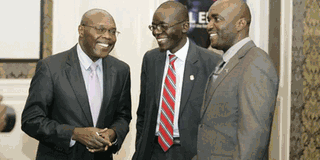How KPL spent Sh270m revenue from last season

Gor Mahia and Kenya Premier League Clubs chairman Ambrose Rachier (left) shares a light moment with KCB Football Club chairman George Odhiambo (centre) with Kenya Premier League Chief Executive Officer Jack Oguda on January 25, 2015. PHOTO | CHRIS OMOLLO | NATION MEDIA GROUP
What you need to know:
- In a bid to cope with the financial glut that has been occasioned by the exit of South African broadcasters SuperSport at the beginning of the year, KPL Ltd’s finance committee has struck out a number of items in the 2017 budget, among them the KPL Top 8 tournament, Under-20 tournament, a proposed Under-16 tournament, Corporate Social Responsibility and hiring of floodlights for night games.
- The company has however set aside Sh20 million for the KPL awards at the end of the season.
Grants to clubs, staff salaries and marketing fees got the lion’s share of Kenyan Premier League Limited’s budget as the body that runs Kenya’s top-flight football league wound up with a loss of Sh4.089 million last year.
The Kenyan Premier League Limited, formed in 2003, is made of of the 18 teams that play in the Kenyan Premier League which is currently sponsored by betting company SportPesa.
KPL Ltd’s financial cycle runs from January to December each year. The chairmanship is held on a rotational basis. Chairman of a club that wins the league becomes KPL Ltd’s chairman in the succeeding season until a new champion is crowed.
Ambrose Rachier, chairman of 2015 league champions Gor Mahia, was KPL Ltd chairman in 2016, a position he relinquished to Tusker’s James Musyoki at the beginning of this year. But Musyoki resigned a few month’s later, and Rachier took over as chairman, a position he currently holds on interim basis.
A copy of the company’s financial statements seen by Nation Sport indicates that out of the Sh270.9 million total income controlled by KPL in 2016, the company spent a total of Sh19.5 million on marketing and advertising, and Sh13.3 million on nine staff members currently on the company’s payroll.
Frontiers Marketing Company, contracted in 2015 as KPL’s commercial agent to help it source for a sponsors for the top-flight league, accounted for Sh10.2 million last year.
A separate Sh9.3 million went into hiring trucks (Sh1.56 million), branding (Sh2.1 million), Live coverage fees (Sh1.2 million) among other things itemised “advertising and promotion” in the financial statement.
Whether Frontiers Marketing Company has increased the market appeal of the top-flight is up for debate. The expenditure raises fears of duplication of functions as its is difficult to see how the company’s roles differ from advertising and promotion which consumed almost equal amount of money.
Long-serving KPL CEO Jack Oguda defended the decision to outsource marketing services.
“Frontiers are tasked with bringing in sponsors, and there is a percentage (of money) they take out of every financial deal that the company enters. The other bit is done within the organisation, mostly promoting the brand and increasing the presence of KPL,” Oguda said.
Apart from Sh13 million spent on nine employees in 2016, KPL also paid Sh1.22 million separately in travel and entertainment allowances to Rachier and Oguda while on overseas duties.
KPL Ltd’s Governing Council, a body made up of chairmen of all league clubs, got Sh4.26 in sitting allowances, as the executive committee earned an additional Sh1.4 million for attending meetings.
The council has proposed a similar expenditure for the two officials this financial year, even as important tournaments such as the KPL Top Eight and the Under-20 tournament have been scrapped following the exit of broadcast sponsors SuperSport.
Stadia safety and security took Sh1.3 million from the budget, and Sh689,000 was spent on hiring a public address system in 2016, bringing the total cost of running the league last season to Sh9.96 million.
But clubs that took part in the top league last year got handsome rewards in financial grants. The 16 clubs in last season’s league shared out Sh135 million among themselves, and the figure is set to go up to 152 million this year, although the teams have increased to 18 this season.
Each of the 16 clubs was entitled to a Sh8 million grant during that period, and an additional Sh7 million was shared among the 16 depending on their position in the league at the end of the season.
In light of the expanded league this season, Football Kenya Federation was expected to add Sh24.5 million to bear the cost of an additional two teams.
Documents show that FKF has only paid up Sh4 million so far. For winning last season’s league title, Tusker received Sh4.5 million as Gor Mahia, Ulinzi Stars and Posta Rangers received Sh1.5 million, Sh1 million and Sh750,000 respectively for finishing second, third and fourth respectively in the league.
At Sh12.2 million, remuneration and facilitation of match officials also commanded a sizeable chunk of last season’s budget. The figure is projected to rise to Sh16.3 million this season due to an expanded league.
In a bid to cope with the financial glut that has been occasioned by the exit of South African broadcasters SuperSport at the beginning of the year, KPL Ltd’s finance committee has struck out a number of items in the 2017 budget, among them the KPL Top 8 tournament, Under-20 tournament, a proposed Under-16 tournament, Corporate Social Responsibility and hiring of floodlights for night games.
The company has however set aside Sh20 million for the KPL awards at the end of the season.





